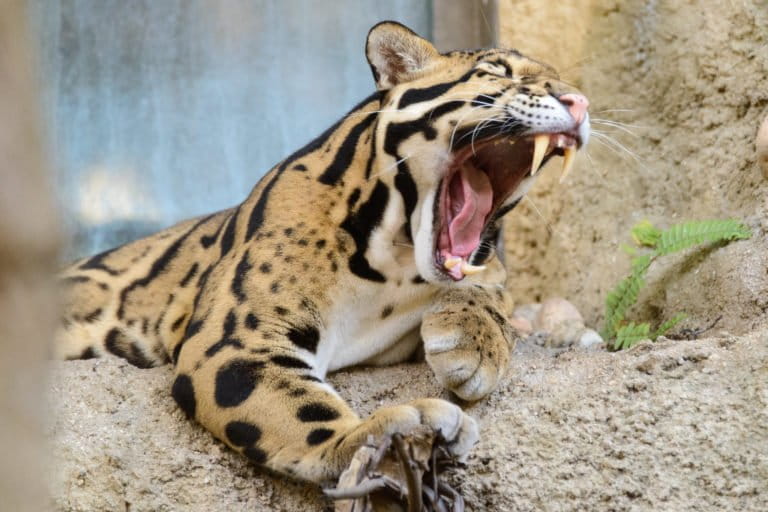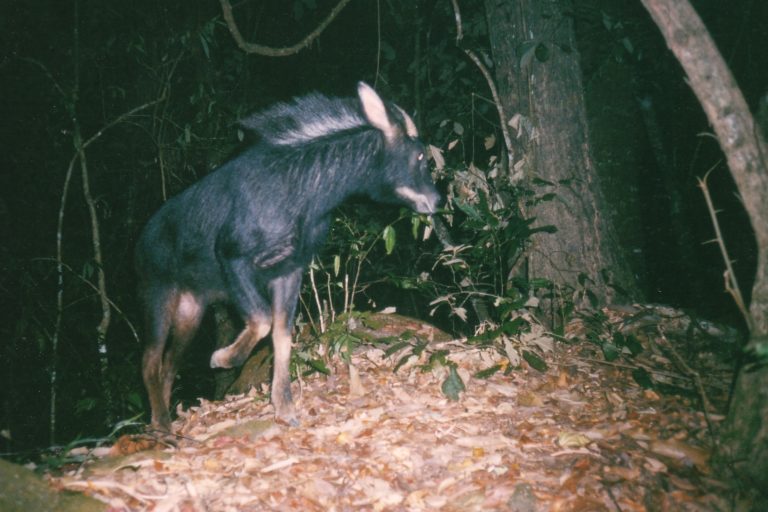- A new study demonstrates that ungulates like serow are important prey for tigers and clouded leopards living in dense evergreen forests in mainland Southeast Asia.
- Numbers of these big cats are dwindling in the region due to direct killing to supply the illegal wildlife trade and the snaring crisis, which both kills the cats and severely depletes their prey populations.
- The findings go against the popular belief that clouded leopards, which spend a portion of their lives in the tree canopy, prefer to prey on primates, other arboreal species and small deer.
- Carnivore experts say the new insights will help to inform efforts to restore prey populations in the region — a key part of boosting flagging big cat numbers.
Tigers and clouded leopards are two of Southeast Asia’s most threatened and enigmatic big cat species. With the numbers of both in sharp decline across the region, leaving their remaining populations small and fragmented, it’s unsurprising that scientists know very little about basic things — such as what they eat.
But now, a new study that analyzed scat samples collected in a remote protected area in northern Laos provides new insights into their dietary preferences. As expected, wild pigs feature prominently on the menu for both tigers (Panthera tigris) and mainland clouded leopards (Neofelis nebulosa). However, both species appear to deliberately seek out a mysterious, goat-like ungulate called the serow (Capricornis sumatraensis) over all other prey, according to the findings published in Ecology and Evolution.
The researchers say their study can help direct conservationists toward the most suitable prey species to target for recovery in their efforts to boost flagging big cat numbers across the region.
“Management and enhancement of serow populations, along with other ungulate species, is likely to be important for the clouded leopard to persist and for tiger population recovery in some areas of Southeast Asia,” Akchousanh Rasphone, Laos conservation science director at the Wildlife Conservation Society and lead author of the study, told Mongabay.

DNA gives clues about cats long gone
Once ranging widely across Asia, tigers and clouded leopards have seen their populations devastated over the past century by habitat loss, direct killing to supply the illegal wildlife trade, and indiscriminate snaring that slays the big cats as well as their prey.
Although tigers are recovering in parts of South Asia, they’re absent from vast portions of suitable habitat in mainland Southeast Asia and functionally extinct in Cambodia, Laos and Vietnam. Meanwhile, the latest conservation assessment of mainland clouded leopards by the IUCN, the global wildlife conservation authority, estimated that their abundance and distribution has shrunk by more than 30% within just the last three generations.
The last known confirmed sightings of tigers in Laos were in Nam Et-Phou Louey National Protected Area, a remote and rugged park spanning nearly 6,000 square kilometers (2,300 square miles) in the north of the country. Camera-trapping surveys by Oxford University researchers in 2013 showed that at least two individuals remained, but lack of subsequent sightings following an “exponential” increase in illegal snaring within the park led the researchers to declare the species locally extinct in 2019.
Prior to this declaration, Rasphone and her colleagues had opportunistically bagged animal dung from trails throughout the high-elevation forests of Nam Et-Phou Louey during camera-trap surveys. Over a four-year period between 2008 and 2012, the team amassed 361 scat samples from a range of species.
Mitochondrial DNA analysis indicated that the fecal haul included 14 clouded leopard and 21 tiger scats. The researchers then used further DNA analysis to identify prey species from individual hairs found within the scats, distinguishing seven species within clouded leopard scats and eight in tiger scats. The team then modeled the availability of different types of prey in the protected area to ascertain whether the predators favored certain species above others.

A mysterious goat-donkey-antelope
While a variety of ungulates, rodents and carnivores were found within the scats, the researchers’ models showed that both big cats had a penchant for mainland serow.
“I am not surprised that the tiger takes the serow, but I am surprised that the clouded leopard, a much smaller cat (some 10-20 kg [22-44 pounds] only) can prey successfully on an ungulate [several] times bigger,” said Sandro Lovari, an ecology professor at the University of Siena in Italy, who was not involved in the research.
Serows are typically nocturnal and look like a cross between a goat, a donkey and an antelope, according to Lovari, who heads up the IUCN’s Caprinae Specialist Group. Due to their elusive habits, Lovari said they’re challenging animals to study. Moreover, their odd, perhaps even “ugly,” appearance adds to the difficulty of convincing funders to support serow research, he added.
As a result, not a lot is known about their basic biology and behavior, leading to concerns that the species, currently assessed as vulnerable on the IUCN Red list, could be lost from many forests without anyone noticing. Lovari said that by highlighting how serows are important prey species for iconic big cats like tigers and clouded leopards, the new study underscores the need for more knowledge about them.

A living saber-tooth
The finding that clouded leopards hunt large animals like wild pigs, serow and hog badgers on the ground goes against the popular belief that these partly arboreal medium-size cats prey on primates and very small deer. In fact, the researchers found no primates or small deer traces in clouded leopard scats at all.
The researchers suggest that the unusual diet of clouded leopards could be down to a number of factors. First, clouded leopards have extraordinary skull and teeth adaptations akin to now-extinct saber-toothed cats. Among all cat species, they have the longest canines and can open their jaws the widest relative to their body size, which allows them to take down prey much larger than themselves using a deadly bite to the back of the neck, rather than relying on suffocation by biting the throat like most other cat species.
Second, macaques, which are the most abundant primates in Nam Et-Phou Louey, use social group defenses to ward off arboreal predators, a tactic also employed by wild pigs and sambar deer, the study notes. This could explain the big cats’ preference for serow, an animal that lacks tusks and large horns and lives a solitary life, perhaps making them easier to stalk and safer to handle. And finally, the researchers observe that their surveys were conducted mostly during the dry season, which might have given their results a seasonal bias.

Toward enhanced prey and more cats
Thomas Gray, tiger landscape and recovery lead at WWF, who was not involved in the study, said the finding that clouded leopards depend on a largely terrestrial, ungulate-based diet, demonstrates to conservationists that a focus on ungulate recovery is paramount to the recovery of big cats. “We can’t assume that [clouded leopards] may be able to hold on in areas where ungulate numbers are being lost due to the snaring crisis,” he said.
Tiger restoration initiatives, such as those between WWF and the governments of Thailand and Malaysia, seek to reintroduce tiger prey species like captive-bred sambar to tiger landscapes. Accordingly, Gray said, they could benefit from considering additional species like serow. Similarly, new information about optimal big cat prey species is instrumental in planning future tiger reintroductions in countries where they have been extirpated.
“There are plans, ideas and discussions around tiger reintroduction in Cambodia … and there are quite healthy populations of serow there,” Gray said. “So if evidence now suggests that serow are a potentially important prey species for tigers and clouded leopards, that’s important and interesting for planning reintroductions.”
But prey population recovery is not the only priority in big cat conservation, according to Gray. More effort is needed to curtail poaching and eradicate snares through strengthened law enforcement and ranger patrols to ensure that reintroduced ungulates aren’t subsequently hunted or killed. “When the tigers were lost in Nam Et-Phou Louey, they had a fraction of the rangers that they really needed to reduce the snaring and hunting threat,” he said.
The snaring crisis underlies prey depletion and big cat deaths in mainland Southeast Asia, Gray said, and ultimately needs to be addressed through removing the demand for wild species. “Reducing the demand for wild meat consumption in middle-class urban people in Southeast Asian cities: That absolutely has to be the long-term goal.”
Citations:
Rasphone, A., Bousa, A., Vongkhamheng, C., Kamler, J. F., Johnson, A., & Macdonald, D. W. (2022). Diet and prey selection of clouded leopards and tigers in Laos. Ecology and Evolution, 12(7). doi:10.1002/ece3.9067
Petersen, W. J., Savini, T., & Ngoprasert, D. (2020). Strongholds under siege: Range-wide deforestation and poaching threaten mainland clouded leopards (Neofelis nebulosa). Global Ecology and Conservation, 24, e01354. doi:10.1016/j.gecco.2020.e01354
Rasphone, A., Kéry, M., Kamler, J. F., & Macdonald, D. W. (2019). Documenting the demise of tiger and leopard, and the status of other carnivores and prey, in Lao PDR’s most prized protected area: Nam et – Phou Louey. Global Ecology and Conservation, 20, e00766. doi:10.1016/j.gecco.2019.e00766
Banner image: Clouded leopards, having experienced a 30% dip in numbers over the past three generations, are deemed as vulnerable to extinction by the IUCN. Image by zoofanatic via Creative Commons (CC BY 2.0)
Carolyn Cowan is a staff writer for Mongabay. Follow her on Twitter @CarolynCowan11
FEEDBACK: Use this form to send a message to the author of this post. If you want to post a public comment, you can do that at the bottom of the page.
